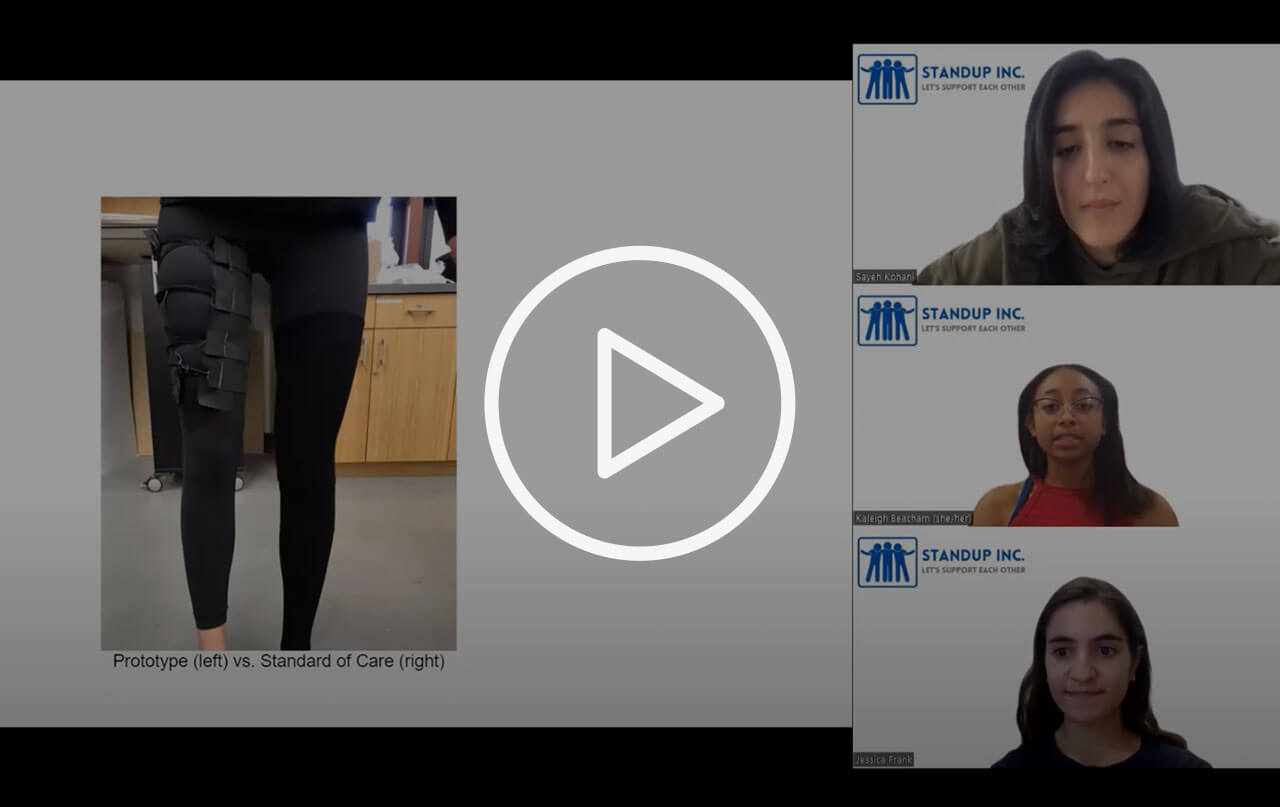Health Technology Showcase
Five Questions and an Elevator Pitch: Stand Up Inc.
 Members of the Stand-Up Inc. team describe the compelling need behind their project and their novel solution.
Members of the Stand-Up Inc. team describe the compelling need behind their project and their novel solution.
1. What is the need that your project seeks to address?
Sayeh: When the three of us started researching orthostatic hypotension, we quickly became interested in compression leggings, which are the current standard of care. Specifically for elderly patients, products that are on the market now are impossible to use. I'm a 20-year-old in somewhat decent shape and I found them difficult to put on.
It was exciting to start thinking about how we could make something more accessible to patients who may not have the strength to put on the standard of care, while also mitigating the side effects we see with the compression garments that are on the market now. For example, because the leggings are always compressed when a patient is sitting down, they can cause blood pressure to become too high. We wanted selective activation so the garment is only compressed when they want it to be compressed.
2. How does your solution work?
Sayeh: The solution we’ve developed is a new type of compression garment that is loose when in an inactive state, like a comfortable pair of leggings. They're easy to put on. And they contain a series of components—the leggings, a motor, and a sensor. The sensor detects a change in position and communicates with the motor. Upon standing, the sensor activates the motor and the motor pulls on strings, like a corset, to tighten the leggings and provide compression when it’s needed. Upon sitting down, the sensor instructs the motor to release the strings so that the leggings become loose again.
3. What activities have you undertaken on the project since completing the course?
Kaleigh: We finished the prototype during the time we were in the Senior Bioengineering Capstone class. Since then, we’ve focused on identifying some weaknesses, with the motor being a huge one. The motor in our initial prototype was very large and so would not be comfortable for a person to wear on their body. We’re now exploring the gearing ratio that’s needed to use a smaller motor.
Jessica: We also spent time thinking about how we can better measure pressure in the legs. We started by using pressure sensors that are robust, with the accuracy that we're aiming for. But they’re pretty expensive. That was fine for an early prototype, but knew we would need to bring the cost down. We’re experimenting with other ways to accurately measure pressure, particularly on a curved surface. Most pressure sensors are meant specifically for use on a hard, flat surface, so it introduces more ‘noise’ into the data than we were initially expecting.
4. What’s the most important thing you learned in advancing your project?
Kaleigh: One thing is that I wish we wuold have explored the the literature a bit more. We went into the patent search much later in the project. This has its advantages so you're not clouded by what other people are doing. But we got to a point when we realized that our idea isn't as new as we thought it was. and it might be a bit more difficult to enter the space than we thought it would be.
5. What advice do you have for aspiring health technology innovators?
Sayeh: Teamwork matters. And I feel like I'm incredibly lucky. These two—Kaleigh and Jessica—they're just superstars. They're brilliant and hard working.
Jessica: We really complement each other in skill sets and thought processes so we bring different ideas and perspectives to the table.
Original team members: Jessica Frank, Sayeh Kohani, Kaleigh Beacham
Course: Senior Bioengineering Capstone
Biodesign NEXT funding: Awarded for spring quarter 2022
